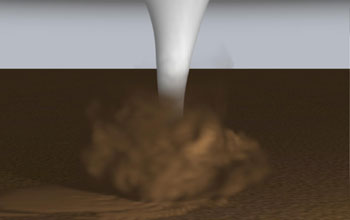Multimedia Gallery
Numerically-simulated tornado moving left to right
A numerically-simulated tornado moving from left to right at 15 miles per second as it ingests 1 millimeter-diameter sand from the surface. Note the thin surface layer that is feeding into the turbulent debris cloud and centrifuging out around the lower part of the funnel, formed from condensing water droplets. This research was supported by National Science Foundation (NSF) grant ATM 0236667. (Date of Image: August 2004)
More about this Image
This image was created from numerical simulation data was custom made ray-casting and lighting software. For the funnel cloud, the condensed water vapor at each point was calculated from simulated pressure values, assuming a reasonable temperature and water vapor mixing ratio. Both condensed water droplets (white) and debris particles (brown) were then treated as solid color fields of varying opacities, illuminated by a spotlight to the right and a constant ambient lighting.
The numerical simulation involves an unsteady, fully 3-D high-resolution computation of the basic fluid dynamic equations including fine debris as a second fluid. This research is part of a continuing effort, supported by NSF, on the near-surface intensification of tornado winds. It has shown that the presence of debris can significantly change the structure of low-level winds in a tornado (see paper 15.5, American Meteorological Society's 22nd Conference on Severe Local Storms, October 2004, [http://ams.confex.com/ams/pdfpapers/81449.pdf]). The local debris mass near the surface can significantly exceed that of the air and remain important to altitudes of several 100 meters, particularly when fine particles are available to be picked up from the surface. For different conditions, the addition of debris can either increase or decrease the damage potential of the tornado.
Credit: Research and simulation by D.C. Lewellen, Baiyun Gong and W. S. Lewellen, West Virginia University. Visualization by Paul Lewellen
Images and other media in the National Science Foundation Multimedia Gallery are available for use in print and electronic material by NSF employees, members of the media, university staff, teachers and the general public. All media in the gallery are intended for personal, educational and nonprofit/non-commercial use only.
Images credited to the National Science Foundation, a federal agency, are in the public domain. The images were created by employees of the United States Government as part of their official duties or prepared by contractors as "works for hire" for NSF. You may freely use NSF-credited images and, at your discretion, credit NSF with a "Courtesy: National Science Foundation" notation.
Additional information about general usage can be found in Conditions.
Also Available:
Download the high-resolution JPG version of the image. (354 KB)
Use your mouse to right-click (Mac users may need to Ctrl-click) the link above and choose the option that will save the file or target to your computer.



